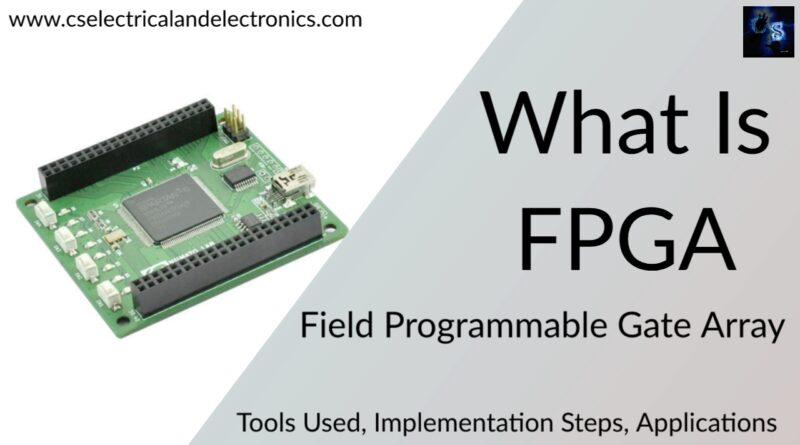What Is FPGA, Field Programmable Gate Array, FPGA Tools
Hello guys, welcome back to my blog. In this article, I will discuss what is FPGA, field programmable gate array, tools used for FPGA development, and what are the applications of FPGA or field programmable gate array.
If you have any doubts related to electrical, electronics, and computer science, then ask question. You can also catch me @ Instagram – Chetan Shidling.
Also, read:
- What Is Unit Testing, Why Unit Testing Is Required, Its Importance
- What Is Linux, Applications Of Linux, Why To Learn Linux
- What Is ANN Controller, Artificial Neural Network (ANN) In MATLAB
What Is FPGA Or Field Programmable Gate Array
A field-programmable gate array or FPGA is an IC or integrated circuit that can be reprogrammed or programmed to the needed functionality or application after building. Major components of field-programmable gate arrays incorporate lower complexity, greater speed, volume designs, and programmable capacities. With further technological advancements, field-programmable gate arrays are a useful suggestion for most designs and businesses.
As the complexity of digital circuits increases, the designing of circuits, making changes, and testing become complicated. So, to avoid this we can write a program based on digital circuits by using some tools. This program of the logic circuit can be used in the FPGA kit for testing logic design, and we can also make changes in the code or program of the logic circuit.
A field-programmable gate array is made up of logic blocks that are programmable, reconfigurable interconnects, and output/inputs pads. The logic blocks utilized in a field-programmable gate array could be made up of memory components such as flip-flops or memory blocks. The logic blocks are able of delivering simple to complicated computational functions.
Field-programmable gate arrays are in several ways related to programmable read-only memory chips. Yet, unlike programmable read-only memory chips, that are restricted to hundreds of gates, a field-programmable gate array can hold many thousand gates. Another notable characteristic of field-programmable gate arrays is the capability to be reprogrammed, unlike application-specific integrated circuits which are built for particular tasks.
How To Use FPGA
As the FPGA or field-programmable gate array is a configurable logic array, the logic requires to be set to match the demands of the system. The configuration is implemented by firmware – a set of data that is
In sense of the complexity of FPGAs, the software is utilized to design the function of a field-programmable gate array or FPGA. The FPGA design process is begun by the user implementing a Hardware Description Language (HDL) definition or a schematic design.
Common HDLs are VHDL (where VHDL holds for VHSIC Hardware Description Language) and Verilog. Once this has held completed the following task in the FPGA design process is to generate a netlist is created for the distinct FPGA family being used. This represents the connectivity needed within the FPGA and it is created using an electronics design automation tool.
The netlist can later be fitted to the original FPGA architecture using a method called place-and-route, normally performed by the FPGA organization’s proprietary place-and-route software.
Lastly, the design is committed to the FPGA and it can be utilized in the electronic circuit board for which it is meant.
Applications Of FPGA
Using the many useful features of FPGA chips into evidence, one can understand the variety of applications that FPGAs would be most satisfied with. They are normally utilized for low volume and high complexity work or projects as they allow customization.
The major FPGA applications are Medical, telecom & datacom, server & cloud, video & image processing, and defense and space.
FPGA chips are utilized in both wireless and wired communications. Meanwhile wired communications, are utilized in serial backplanes, and wireless communications, that are utilized for 5G/6G and HSDP, A networking solutions, and addressing standards of WiMAX and. FPGA is utilized on the infrastructure side helping with crunching data at high speed.
In the area of medical applications, FPGA chips are utilized for diagnostic and monitoring schemes. They are utilized in medical devices to process data.
In the field of aerospace and defense purposes, FPGA chips are utilized for partial reconfigurations for SDRs, image processing, also for waveform generation.
FPGA technology allows ASIC businesses the possibility of rapid prototyping, where ideas and thoughts can be tested, without passing through a long process. FPGA is utilized to increase the time to market different technological products and reduce the overall engineering costs acquired in a number of processes including industrial surveillance and automation.
As FPGA is utilized for reconfigurations and keeping up with qualifications, it decreases the cost of any long-term maintenance required for a system. Even Microsoft developers have a way to FPGA chips, and they operate with open source tools called Microsoft Cognitive Toolkit. Microsoft is using Intel FPGA so that they can improve the use of Al within their works.
In reality, FPGAs are being practiced prominently to improve deep neural networks or DNNs which will eventually lead to the creation and maintenance of artificially intelligent systems. High-performance FPGAs can be of still greater help to an application when compared with GPUs and are thus favored for the prospects of developing machine learning technology.
A recent addition by Intel (bought Altera) and AMD (bought Xilinx) explains how great FPGAs are in the server and computing market, which is apparently a market section that will give an increase for the FPGA market.
Tools Used
01. Develop or build the FPGA VHDL code utilizing the tool Xilinx. Interface to the hardware utilizing the Hardware Interface Layer presented for your FPGA module – we do not suggest you try to modify this!.
02. Logically simulate your FPGA design using Modelsim. ModelSim is a verification and simulation tool for VHDL, SystemVerilog, Verilog, and mixed-language designs.
03. Download this FPGA program to the hardware utilizing the Hunt Engineering tools. Hunt Engineering products are followed by a CD including all software tools, manuals, tutorials, multimedia presentations.
04. Debug the FPGA using ChipScope™ tools from Xilinx. The Xilinx ISE is originally utilized for circuit synthesis and design, while the ModelSim logic simulator or ISIM is utilized for system-level testing.
05. Load any DSP code, debug it with the Code Composer Studio and also test the system.
06. As can be observed, if your system involves both DSP processor and FPGA we suggest treating development as two separate steps. Develop the FPGA and make assured it’s correct; then shift to developing or building the DSP processor code. This can be performed iteratively – develop or build a basic FPGA, then a basic DSP program, then return to improve the FPGA code.
I hope this article may help you all a lot. Thank you for reading.
Also, read:
- 100 + Electrical Engineering Projects For Students, Engineers
- 1000+ Electronics Projects For Engineers, Diploma, MTech Students
- 1000+ MATLAB Simulink Projects For MTech, Engineering Students
- 500+ Embedded System Projects For Engineer, Diploma, MTech, PhD
- 500+ Projects For Diploma Electrical, Electronics Student, Diploma Project
- 8051 Microcontroller Timers, TCON Register, TMOD Register
- Advancements In 3D Printing Technology And It’s Future
- Advancements In Power Electronics For Energy Efficiency
Author Profile
- Chetu
- Interest's ~ Engineering | Entrepreneurship | Politics | History | Travelling | Content Writing | Technology | Cooking
Latest entries
 All PostsApril 29, 2024Top 11 Free Courses On Battery For Engineers With Documents
All PostsApril 29, 2024Top 11 Free Courses On Battery For Engineers With Documents All PostsApril 19, 2024What Is Vector CANoe Tool, Why It Is Used In The Automotive Industry
All PostsApril 19, 2024What Is Vector CANoe Tool, Why It Is Used In The Automotive Industry All PostsApril 13, 2024What Is TCM, Transmission Control Module, Working, Purpose,
All PostsApril 13, 2024What Is TCM, Transmission Control Module, Working, Purpose, All PostsApril 12, 2024Top 100 HiL hardware in loop Interview Questions With Answers For Engineers
All PostsApril 12, 2024Top 100 HiL hardware in loop Interview Questions With Answers For Engineers








